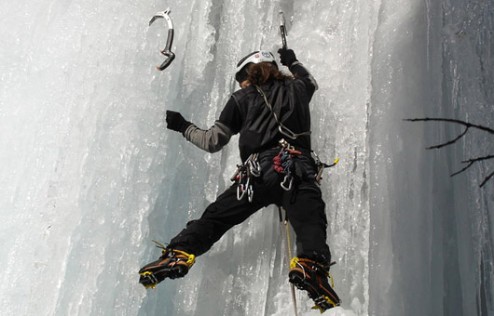Winter Climbing Overview
The Basics – Axes Crampons and Approach Work
Before attempting Winter climbing you should have a solid grounding in Winter Skills, Ropework and Navigation.
Ice axes and crampons are the common tools shared by winter hillwalkers and winter climbers, the skill set in using them is similar but when climbing they often apply on steeper ground which can push your skill level harder and often limits your choice of action.

Your ice axe is the going to be your most used piece of equipment so learn to use it properly; practice ice axe arresting on a safe slope with some friends (forward, backward, somersault, head first – they can all happen). Learn how to use your axe on steeper ground and when to change from shaft to pick as your main anchor.
Learn how to profile a slope before you climb; avalanches are fairly common in Scotland. By being able to assess the slope accurately you could save a life (yours) and save yourself a wasted trip to a gully when you should be climbing a ridge.
Walking poles and axes. Poles make the ascent to the foot of a climb less painful and there is a temptation to keep them out even when the slope is getting steeper and the run out is starting to look a bit dodgy. The problem is that they cannot stop you if you slip – as soon as there is an objective danger from a fall put the poles away and get the ice axe out.
One axe or two? It is common nowadays to see climbers using 2 axes on technically easy ground; this is often done because it feels more secure to have two pieces of kit ‘attaching’ you to the mountain but it really limits your ability to self arrest if a slip occurs. A simple rule of thumb; if you think you can self arrest on the slope then use a single axe, if you do not think you can self arrest and you have a second axe use it but be very aware that you a entering ‘solo climbing’ territory and consider the risks carefully.
Crampons are pretty much necessary once you get onto steeper ground. Make sure that your crampons fit the boots you are wearing before you try to fit them on the hill. Try to use good judgement and put your crampons on in a safe place before they become necessary – it’s much easier and quicker. Check the straps and fixing regularly for wear and tear or damage. Snow collecting under the crampon can render them useless and more dangerous than not having crampons at all. Anti-balling plates are available for most makes and feel like they are worth their weight in gold in sticky snow conditions.
Getting the rope out?
Fairly straight forward, you get the rope out when you are about to climb, right? Not always, what about that gully climb that started out so easy you decided to solo it then see the monster cornice at the top? Or the great firm neve that changes to crusted mush further up the slope? It is far harder to estimate the difficulty of a winter ascent compared to a summer one and most people get caught out now and then.
The only thing you can really do is be aware of the changing conditions around you and be prepared. When it’s time to get the rope out you should know exactly what you plan to do – winter is no time for faffing around or trying to remember how that knot ties.
This is where your summer climbing skills should help; the ability to get your kit sorted and a belay set up quickly is much more valuable in Winter when it’s cold and daylight hours are few. The added twist to rope work in Winter is – Winter. Wet ropes and slings will freeze solid, belays are often buried / iced up / un-findable, communication with your partner is impossible, your hands are like blocks of ice and you can’t feel your fingers… All the more reason to practice and get slick – if you know what you are doing you stay safer and warmer and can actually enjoy the situation rather than endure it.
Tips
Choose the right route – not easy to get right but use all available means to determine what is a good bet: Conditions reports/blogs, gully or ridge, turf or ice, East or West. Choose a grade that is good for the team – if you have a new partner it might be better to re visit a well know haunt rather than push your boundaries.
Take the right gear for the route – when you have decided which (type) of route you are heading for sort the gear out. No point in carrying a full rack of ice screws for a mixed route is there? Take enough gear to safeguard the route + a couple of just in case bits for when conditions are really different from what you thought they would be.

Leave a Reply